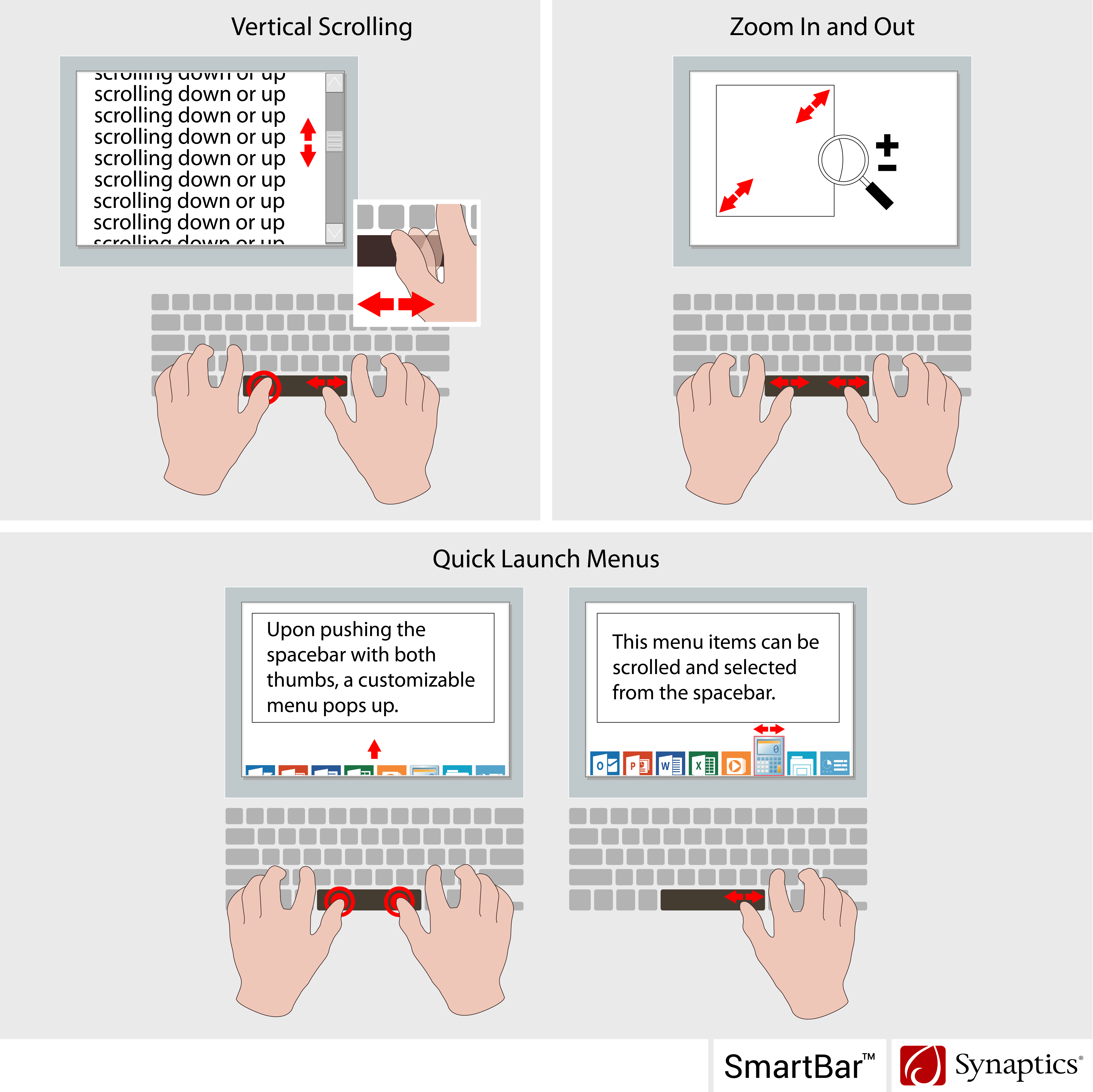A TouchPad On The Spacebar? Interesting Idea, Synaptics
The technologies Synaptics creates -- human interface solutions -- are sold to OEMs that integrate them into their own products. Today, the company announced a new addition to that portfolio with SmartBar technology, a first of its kind innovation that attempts to make use of the underutilized real estate on the space bar of a typical keyboard.
The range of products Synaptics makes can be loosely summed up as touch sensitive. If you've used a recent smart phone, tablet, or even TouchPad on a laptop, you've likely experienced what they do, and may not even know it.

SmartBar technology adds capacitive touch sensing to the space bar and allows finger-based gestures to be used. Synaptics believes including a touch sensor to the spacebar will enable users to adapt ways to quickly edit text and zoom in. SmartBar can be configured with up to five Programmable Logical Buttons with an included macro suite that allows for programmability of custom functions, letting OEMs or perhaps users come up with their own gesture-based functions.
Editing your documents is made easy with Rapid Editing. Performed with a single swipe of your thumb, this action will highlight the word located in front or behind the cursor, relative to the direction of your swipe.
Zoom also sounds like a nice feature. Desktop PCs have for the most part lacked the ability to pinch-zoom; with a SmartBar installed, the possibility exists. Synaptics calls this Effortless Zooming, and it's done with the use of two thumbs. Pinch and expand are both supported and can be used with text or images alike.
This new technology is available to OEMs today for integration into their own products. Tt Sports is among the first to integrate SmartBars into gaming keyboards. We'll be sure to report on any more that pop up.
Follow us @tomshardware, on Facebook and on Google+.
Stay On the Cutting Edge: Get the Tom's Hardware Newsletter
Get Tom's Hardware's best news and in-depth reviews, straight to your inbox.
Kevin Carbotte is a contributing writer for Tom's Hardware who primarily covers VR and AR hardware. He has been writing for us for more than four years.
-
AnimeMania SmartBar shouldn't be added to the "Space Bar", but to the plastic bezel of the keyboard that is just below the "Space Bar". Many people rest their thumbs on the "Space Bar" just before they are ready to type something. This action might result in inadvertent activation of the SmartBar and if that person does not know that they have a SmartBar enabled system, might assume that their computer system is malfunctioning.Reply -
iPanda wonder how fast these operations process. if there is no lag and has a toggle (assume most games might get finnicky with it), seems like a nice bonus. Well, unless it adds g-sync prices to the keyboard lol...Reply -
hp79 They should get their track pads to work better before trying something else. Apple's track pad works very well in OSX. Why can't Synaptics make it like that for Windows?Reply -
kittle ReplyThey should get their track pads to work better before trying something else. Apple's track pad works very well in OSX. Why can't Synaptics make it like that for Windows?
+1 to this. most trackpads I cant stand because they are always moving the mouse cursor when I dont want or clicking when I dont want.
Come back when you can play FPS-like games on a trackpad, and you've got my money. -
tech-wreck no. just, no.Reply
typing on a laptop annoys the crap out of me when i accidentally hit the trackpad and continue typing in the middle typing and wonder why my text isn't there.of an earlier sentence. or if I'm typing in a text box and click out of it but keep
^that was deliberate, so I'm not editing it. but when i don't intend to be illiterate i could put my fist through the screen. -
PaulBags A nice idea, with smartphones so prevalent touch gestures have become more of an intuitive responsive to "how I do this?". I've used keyboard and mouse much longer than touch screens, and yet the other day found myself thinking "yeah but I don't have two cursors so how do I manipulate that?" (forgot the exact scenario).Reply
Still, I don't think placement on the spacebar is the way to go. Do people not use hotkeys anymore? "Quick editing" has existed probably longer than I've been alive, arrow keys move cursor, shift selects, ctrl modifier moves cursors words rather than charactors at a time, home/end move to home/end of a row, ctrl+x = cut ctrl+c = copy ctrl+v = paste, etc. A bunch I forgot and can't test right now, because despite being far easier to use that grab bars and other touch text editing 'innovations' hotkey editing rarely works in android - even with a physical keyboard. -
salgado18 ReplyThey should get their track pads to work better before trying something else. Apple's track pad works very well in OSX. Why can't Synaptics make it like that for Windows?
Apple's track pad is the best track pad I've ever used, but half of its goodness comes from OSX, which was designed with such a device and navigation in mind.
Using the same track pad on a Bootcamp instalation of Windows is almost like using any other pad, so I believe the fault is on Windows.
Think about it, OSX scrolls pages smoothly, while Windows only does steps, even if smoothing between them. You need to get Windows right before touching trackpads.
And agree on the placement of the sensitive area on the space bar. I mean, how are we using it? Is it a trackpad replacing the spacebar, or a trackpad built over the flat area of the key? Do we push it down like before, or a quick touch works as a space? I don't see it working as well in both funcionalities.